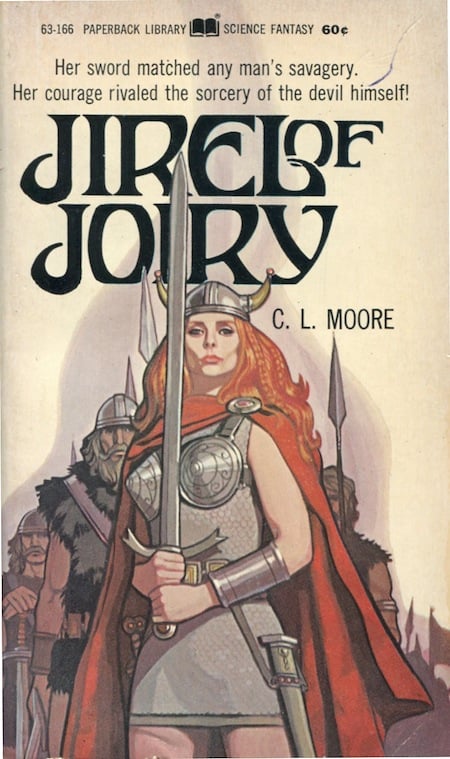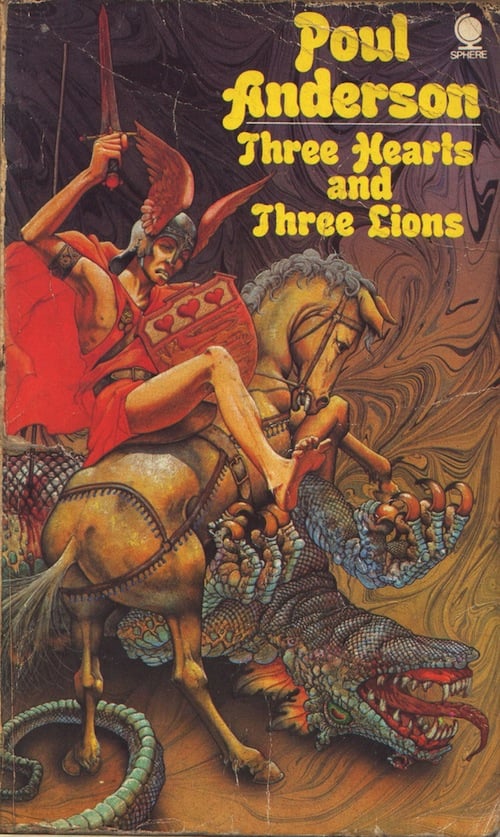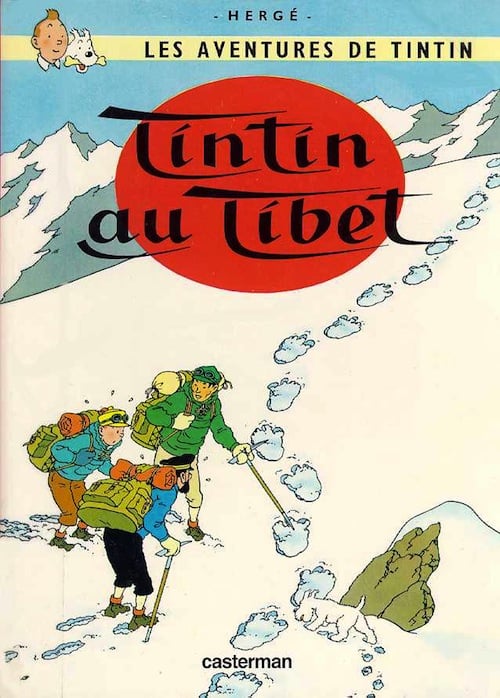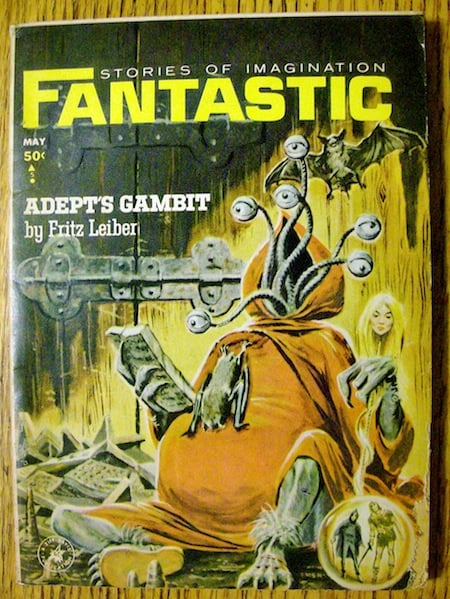65 Fantasy Adventures
By:
November 13, 2013

Recently, I compiled a list of two hundred of my favorite adventures published before the Eighties (1984–1993).
Twenty-three of the titles on that list are fantasy adventures. Also, via the following posts — Best 19th Century Adventure (1805–1903) | Best Nineteen-Oughts Adventure (1904–1913) | Best Nineteen-Teens Adventure (1914–1923) | Best Twenties Adventure (1924–1933) | Best Thirties Adventure (1934–1943) | Best Forties Adventure (1944–1953) | Best Fifties Adventure (1954–1963) | Best Sixties Adventure (1964–1973) | Best Seventies Adventure (1974–1983) — I listed another two hundred and fifty of my favorite adventures. Forty-two of the titles on those secondary lists are fantasy.
Thus — below, please find a list of sixty-five of my favorite fantasy adventures — arranged not qualitatively (which would be impossible) but chronologically. The titles marked with an asterisk (*) are from my Top 200 Adventures list; the others are second-tier favorites.
A couple of quick notes: Why no H.P. Lovecraft? Because I’ve classified him as an sf author. Why is there a Tarzan novel here, when most of the Tarzan books are classified (by me) as atavistic adventures? Because in this one he shrinks to the size of an ant! Pippi Longstocking? Inhuman strength. Aren’t Lost Horizon and Tintin in Tibet exploration adventures? Yes, but: the secret of longevity in the former, levitating monk and hairy cryptid in the latter.

JOSH GLENN’S *BEST ADVENTURES* LISTS: BEST 250 ADVENTURES OF THE 20TH CENTURY | 100 BEST OUGHTS ADVENTURES | 100 BEST RADIUM AGE (PROTO-)SCI-FI ADVENTURES | 100 BEST TEENS ADVENTURES | 100 BEST TWENTIES ADVENTURES | 100 BEST THIRTIES ADVENTURES | 75 BEST GOLDEN AGE SCI-FI ADVENTURES | 100 BEST FORTIES ADVENTURES | 100 BEST FIFTIES ADVENTURES | 100 BEST SIXTIES ADVENTURES | 75 BEST NEW WAVE SCI FI ADVENTURES | 100 BEST SEVENTIES ADVENTURES | 100 BEST EIGHTIES ADVENTURES | 75 BEST DIAMOND AGE SCI-FI ADVENTURES | 100 BEST NINETIES ADVENTURES (in progress) | 1994 | 1995 | 1996 | 1997 | 1998 | 1999 | 2000 | 2001 | 2002 | 2003 | NOTES ON 21st-CENTURY ADVENTURES.
MORE FANTASY ON HILOBROW: CROM YOUR ENTHUSIASM series | 65 Fantasy Adventures | Mervyn Peake | Lord Dunsany | H.P. Lovecraft | Edgar Rice Burroughs | Ursula K. LeGuin | Michael Moorcock | Gary Gygax | Clark Ashton Smith | Frank Frazetta | George MacDonald | John Bellairs | T.H. White | Wilkie Collins | M.R. James | Edgar Allan Poe | Lewis Carroll | Mikhail Bulgakov | Guy Endore | Alasdair Gray | Maurice Sendak | Tove Jansson | L. Frank Baum | Roald Dahl | Abraham Merritt | August Derleth | William Hope Hodgson | Madeleine L’Engle
Why does my Top Adventures List project stop in 1983? Primarily because I figure that adventure fans already know which adventure novels from the Eighties, Nineties, and Twenty-Oughts are worth reading; I’m interested in directing attention to older, sometimes obscure or forgotten adventures. Also, I have friends who’ve published adventures since 1983 — I don’t want these lists to be biased!
In chronological order, here is the list of my Top 65 Fantasy Adventures.
- 1860. Paul Féval’s vampire adventure Knightshade (French: Le Chevalier Ténèbre).
- * 1865. Lewis Carroll’s fantasy adventure Alice’s Adventures in Wonderland.
- 1871. Lewis Carroll’s fantasy adventure Through the Looking-Glass. Enter the Jabberwocky!
- 1889. William Morris’s fantasy adventure The House of the Wolfings. An important influence on J.R.R. Tolkien.
- 1889. William Morris’s fantasy adventure The Story of the Glittering Plain.
- * 1897. Bram Stoker’s supernatural horror adventure Dracula, whose readers know what kind of monster the protagonists seek before they do. Described by Neil Gaiman as a “Victorian high-tech thriller,” the book’s use of cutting-edge technology — and true-crime story telling, from newspaper clippings to phonograph-recorded notes — creates an eerily realistic vibe.
- 1900. L. Frank Baum’s fantasy adventure The Wonderful Wizard of Oz.
- 1904. J.M. Barrie’s play Peter Pan. Turned into the 1911 novel Peter and Wendy.
- 1904. L. Frank Baum’s The Marvelous Land of Oz, sequel to The Wizard of Oz. A boy named Tip makes a man out of wood and gives him a pumpkin for a head. A witch brings this creation to life, and one of my favorite Oz adventures begins.
- 1906. Edith Nesbit’s YA novel The Story of the Amulet deserves a mention here.
- * 1907. L. Frank Baum’s Oz fantasy adventure Ozma of Oz. My favorite Oz book — in which Dorothy Gale and a talking hen (Billina) wash up in the Land of Ev, where they encounter proto-steampunk Wheelers, the wicked Nome King, and Baum’s greatest character, Tik-Tok the mechanical man.
- * 1908. Kenneth Grahame’s children’s book The Wind in the Willows. Not an adventure in every particular, but Toad’s wild ride and prison break are amazing, as is the battle to reclaim Toad Hall from the weasels, stoats, and ferrets who’ve invaded from the Wild Wood.
- 1908. William Hope Hodgson’s supernatural adventure The House on the Borderland. The titular house is built over a pit… that is in some way connected with the universe… and from which swine-things come and go in the night. The narrator has a cosmic vision of Eternity.
- 1911. Bram Stoker’s horror thriller The Lair of the White Worm.
- 1914. L. Frank Baum’s fantasy adventure Tik-Tok of Oz is a personal favorite.
- 1918/1919. A. Merritt’s fantasy adventure The Moon Pool.
- 1918. Sax Rohmer’s supernatural adventure Brood of the Witch Queen. Considered one of the author’s best novels.
- * 1919. James Branch Cabell’s comical fantasy adventure Jurgen, A Comedy of Justice. In search of courtly love, the protagonist — a poet, who is allowed to relive a year of his youth — journeys through fantastic realms. The novel’s sexual content caused a storm of controversy. Aleister Crowley was a fan, and Robert Heinlein patterned Stranger in a Strange Land after it. Fun fact: Serialized here at HILOBROW.
- 1920. Hugh Lofting’s children’s adventure The Story of Doctor Dolittle deserves a mention here.
- 1922. E.R. Eddison’s fantasy adventure The Worm Ouroboros.
- 1924. Edgar Rice Burroughs’s Tarzan and the Ant Men. Serialized and also published in book form the same year. NB: This book is mentioned in To Kill A Mockingbird.
- 1924. A. Merritt’s fantasy adventure The Ship of Ishtar.
- 1927. John Buchan’s historical/supernatural adventure Witch Wood. A new minister arrives in a tiny Scottish town, at some point in the 17th Century. Evil lurks there.
- 1930. Charles Williams’s fantasy adventure War in Heaven. Williams was one of the Inklings, the Oxford dons whose number included J.R.R. Tolkien and C.S. Lewis. Murder mystery meets Arthurian romance; a predecessor to Susan Cooper’s YA Dark is Rising series.
- 1931. Nathanael West’s The Dream Life of Balso Snell. A surrealistic fantasy. The author’s blurb announced the book’s “use of the violently dissociated, the dehumanized marvelous, the deliberately criminal and imbecilic.”
- * 1933. James Hilton’s adventure Lost Horizon. A kidnapped Englishman who is temperamentally — thanks to his WWI experience — a philosophical ironist (but not a cynic!) discovers, in a remote Tibetan valley, a quasi-monastic community for whom philosophical irony has been elevated to a noble Weltanschauung.
- * 1933. Guy Endore’s horror/historical adventure The Werewolf of Paris. In a city besieged by the Prussian Army, a young man — who might or might not be a werewolf — begins to feed upon the blood of his willing, perverted lover.
- 1934–39. C.L. Moore’s occult/fantasy adventure Jirel of Joiry. Five stories, about a female adventurer. [Written up in HILOBROW’s CROM YOUR ENTHUSIASM series.]
- 1935. E.R. Eddison’s fantasy adventure Mistress of Mistresses, the first in the Zimiamvian trilogy. These works of high fantasy were highly praised by J.R.R. Tolkien, C.S. Lewis, and Ursula K. LeGuin. [Written up in HILOBROW’s CROM YOUR ENTHUSIASM series.]
- 1936. Fritz Leiber’s first Fafhrd and the Gray Mouser novella, Adept’s Gambit written… but not published until 1947.
- * 1937. J.R.R. Tolkien’s fantasy adventure The Hobbit, in which stay-at-home halfling Bilbo Baggins is persuaded by the wizard Gandalf to travel across Middle Earth and burgle the dragon Smaug’s treasure hoard. Along the way he and his dwarven companions encounter elves and trolls, goblins and wargs, talking spiders, and the twisted creature Gollum. [Written up in HILOBROW’s CROM YOUR ENTHUSIASM series.]
- * 1938. T.H. White’s fantasy adventure The Sword in the Stone. It may have been adapted into a Disney movie, but it’s not for kids. Merlin is weird and wise; Maid Marian is a leather-clad bad-ass; Colonel Cully (a hawk) is insane; King Pellinore is a bumbling fellow who can’t give up his search for the “Questin’ Beast.” From these and other marvelous characters, the Wart learns to be a great king. [Written up in HILOBROW’s CROM YOUR ENTHUSIASM series.]
- 1940. Jack Williamson’s occult adventure Darker Than You Think, a werewolves vs. humans battle. [Written up in HILOBROW’s CROM YOUR ENTHUSIASM series.]
- 1940. L. Sprague de Camp and Fletcher Pratt’s atavastic fantasy adventure The Roaring Trumpet and The Mathematics of Magic. Reissued, with 1941’s The Castle of Iron, in 1975 as The Compleat Enchanter. [Written up in HILOBROW’s CROM YOUR ENTHUSIASM series.]
- * 1941. Fletcher Pratt and L. Sprague de Camp’s fantasy adventure Land of Unreason. An American diplomat is wounded during a WWII air raid in England; while recuperating in Yorkshire, he is transported to the land of Faerie. There, he is recruited by Titania and Oberon, who send him on a secret mission to the totalitarian Kobold Hills (i.e., Germany).
- 1943. Fritz Leiber’s fantasy adventure Conjure Wife, in which a professor who studies primitive rituals and superstitions is targeted by the jealous wife of a colleague — she’s a witch. Luckily for him, so is his wife! In the end, the professor must apply scientific methodology to witchcraft. Adapted as the excellent 1961 horror movie Burn, Witch, Burn. [Written up in HILOBROW’s CROM YOUR ENTHUSIASM series.]
- 1944. Astrid Lindgren’s YA adventure Pippi Longstocking.
- * 1945. E.B. White’s children’s fantasy adventure Stuart Little. A mouse born to a human family races a sailboat in Central Park, gets shipped out to sea in a garbage can, and sets out — several years before Kerouac’s On the Road — on a cross-country odyssey. The book was criticized, at the time, by the New York Public Library’s influential children’s lit expert for being nonaffirmative, inconclusive, and unfit for kids.
- 1946. Henry Kuttner’s (or C.L. Moore’s?) fantasy adventure The Dark World, in which a wartime flyer is drawn into an alternate-reality Earth… and replaced by the ruthless Ganelon, a member of the Dark World’s ruling coven. Published in book form in 1965.
- 1946. Mervyn Peake’s fantasy adventure Titus Groan, first of the Gormenghast series. Peake was a well-known illustrator; his writing is wildly descriptive.
- 1946–50. Maurice Richardson’s fantasy adventure story collection The Exploits of Engelbrecht, about a Dwarf Surrealist boxer’s bouts across time and space. Published in the British magazine Lilliput, the stories were collected as a book in 1950.
- * 1937–49. J.R.R. Tolkien’s fantasy adventure The Lord of the Rings was written during these years. A posse of easy-going hobbits must destroy the One Ring, the ultimate weapon created by the Dark Lord. They are aided by the superhuman ranger Aragorn, the Human Boromir, the Dwarf Gimli, the Elf Legolas, and the wizard Gandalf. The book began as a sequel to The Hobbit, then turned into an epic. Published as a book in 1954–55.
- 1951. C.S. Lewis’s Narnia fantasy adventure Prince Caspian.
- 1952. C.S. Lewis’s Narnia fantasy adventure The Voyage of the Dawn Treader.
- 1953. Poul Anderson’s fantasy adventure Three Hearts and Three Lions, serialized. Holger Carlsen is an Allied covert operative who winds up in a parallel universe, one whose historical past is the Matter of France. There, he must prevent the evil of Faerie from encroaching on humanity. Expanded and published in 1961. NB: The Dungeons & Dragons alignment system was influenced by this book.
- * 1954. Poul Anderson’s fantasy adventure The Broken Sword. Michael Moorcock declared The Broken Sword superior to Tolkien, calling it “a fast-paced doom-drenched tragedy in which human heroism, love and ambition, manipulated by amoral gods, elves and trolls, led inevitably to tragic consequences.” PS: It was influenced by H. Rider Haggard’s 1891 Viking adventure The Saga of Eric Brighteyes.
- * 1955. Crockett Johnson’s children’s dream adventure Harold and the Purple Crayon. A four-year-old with a purple crayon draws an adventure for himself. Along with Ruth Krauss, P.D. Eastman, Syd Hoff, Leo Lionni, Lilian Moore, and William Steig, Johnson (who was author, from 1942–52, of the great newspaper strip Barnaby) was a leftist who raised questions — in an ostensibly playful manner — about our taken-for-granted forms and norms.
- * 1958–59. Hergé’s Tintin adventure Tintin in Tibet, the author’s own favorite of his books. A strange adventure without an antagonist (unless the Yeti counts?), without Calculus or the Thompsons. Just Tintin, Haddock, Snowy, and the sherpa Tharkey, trekking across the Himalayan mountains in search of the sole survivor of a plane crash. An emotional, mystical, funny, weird voyage of redemption. Published as a color album in 1960.
- * 1963. Maurice Sendak’s children’s fantasy adventure Where the Wild Things Are. Forget the self-consciously sad live-action 2009 Spike Jonze/Dave Eggers feature-film adaptation — please! Dressed in a wolf costume, Max goes wild — and is sent to his room, which transforms into a jungle. Max sails to an island inhabited by magnificently grotesque Wild Things, whom he (the most feral thing on the island) subjugates. A Wild Rumpus ensues.
- 1963. Robert A. Heinlein’s fantasy adventure Glory Road.
- 1963. Michael Moorcock’s Elric fantasy adventure The Stealer of Souls.
- 1964. Roald Dahl’s children’s fantasy adventure Charlie and the Chocolate Factory.
- 1968. Ursula K. Le Guin’s Earthsea fantasy adventure A Wizard of Earthsea.
- 1968. James Blish’s fantasy adventure Black Easter. An arms dealer hires a black magician to unleash all the demons of Hell on Earth for a single day.
- 1969. Kingsley Amis’s fantasy adventure The Green Man.
- * 1972. Richard Adams’s epic talking-animal adventure Watership Down, sometimes called the rabbits’ Aeneid. A group of rabbits escape the destruction of their warren and journey across south-central England in search of a new home. Along the way, they encounter predators, snares, and automobiles; and they’re tempted to join un-free rabbit societies; the monstrous rabbit leader of one of these societies leads an attack on their new warren. Fortunately, the nomadic rabbits are resourceful and brave… and they’ve learned how to survive and thrive from the lapine mythology of El-ahrairah the trickster.
- 1972. Angela Carter’s fantasy adventure The Infernal Desire Machines of Dr Hoffman.
- 1973. Poul Anderson’s fantasy/atavistic adventure Hrolf Kraki’s Saga, retelling the story of a legendary 6th-century Danish king from such sources as Iceland’s Hrólfs saga kraka.
- 1973. Susan Cooper’s Dark is Rising YA fantasy adventure The Dark is Rising. The second in a series of five.
- 1973. Alan Garner’s fantasy adventure Red Shift. The author of some of my favorite YA fantasy here portrays a present-day England overlaid by a disintegrating Vietnam-like Roman Britain. A darker version of what Susan Cooper was doing at the same time.
- 1973. William Goldman’s fantasy adventure The Princess Bride. An ironic homage to the genre.
- 1980. Geoffrey Household’s occult adventure The Sending. When Hollaston, an ex-Indian Army colonel, inherits a dead friend’s polecat, he discovers that he has suppressed shamanistic powers… and what’s more, he’s being targeted — via psychic transmissions — by a cult! Four decades after Rogue Male, another great yarn from the great Household.
- 1981. Alasdair Gray’s postmodernist fantasy adventure Lanark. In two of this epic tome’s four sections, a young Glaswegian is driven mad by his inability to form relationships; in the other two sections, Unthank — a Glasgow-like fantasy civilization — disintegrates for the same reason. Are the two narratives connected? Perhaps, perhaps not. In the Epilogue, the author himself tells the protagonist: “A heavy book will make a bigger splash than two light ones.”
- 1981. John Crowley’s fantasy adventure Little, Big. The complex, sprawling, quasi-mythic story of an eccentric family’s relationship with the occluded world of faerie. The family’s members believe that they are each part of a grand supernatural Tale, and that their fates are intertwined with the faeries’ hidden universe. According to Harold Bloom: “A neglected masterpiece. The closest achievement we have to the Alice stories of Lewis Carroll.”
- 1983. Terry Pratchett’s comical fantasy adventure The Colour of Magic, the first book of the Discworld series. Caught up in a boardgame played by the gods of Discworld, the incompetent wizard Rincewind journeys across the Disc with wealthy tourist Twoflower. A sardonic inversion of fantasy; Pratchett has described the book as “an attempt to do for the classical fantasy universe what Blazing Saddles did for Westerns.”






























20 ADVENTURE THEMES AND MEMES: Index to All Adventure Lists | Introduction to Adventure Themes & Memes Series | Index to Entire Series | The Robinsonade (theme: DIY) | The Robinsonade (theme: Un-Alienated Work) | The Robinsonade (theme: Cozy Catastrophe) | The Argonautica (theme: All for One, One for All) | The Argonautica (theme: Crackerjacks) | The Argonautica (theme: Argonaut Folly) | The Argonautica (theme: Beautiful Losers) | The Treasure Hunt | The Frontier Epic | The Picaresque | The Avenger Drama (theme: Secret Identity) | The Avenger Drama (theme: Self-Liberation) | The Avenger Drama (theme: Reluctant Bad-Ass) | The Atavistic Epic | The Hide-And-Go-Seek Game (theme: Artful Dodger) | The Hide-And-Go-Seek Game (theme: Conspiracy Theory) | The Hide-And-Go-Seek Game (theme: Apophenia) | The Survival Epic | The Ruritanian Fantasy | The Escapade

